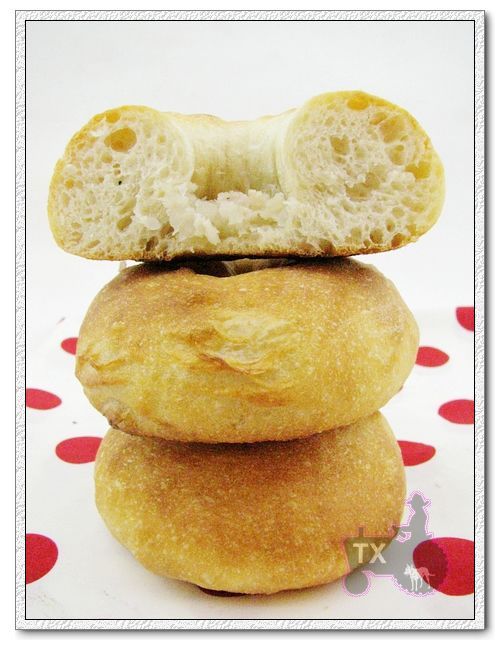
The bagel recipe is from Nancy's Siliverton's book "Breads from the La Brea Bakery". The procedure is very similar to the one in BBA, cold rise, boil, bake, except that it uses some starter in addition to commercial yeast. I like the end product a lot, as happy as I was with the BBA ones, I find these ones are more chewy, the crumb is tighter, more like a true NY bagel. I used various toppings, my favorite one was Asiago Cheese, yum!

I used my 100% starter, and adjust water content accordingly. Also used some baking soda in the boiling water to get that shine. The following is my modified version:
water (70F), 14.5oz
instant yeast, 1.75tsp
white starter (100%), 11oz
high-gluten flour (I used Sir Lancelot), 2lbs
sugar, 2oz
salt, 1tbsp
barley malt syrup, 2tbsp
milk powder, 6tbsp
1. Mix everything until gluten is well developed
2. Rest for 10 minutes
3. divide into 4oz pieces, round and relax for 15 minutes
4. shape into bagels - I use the "connect two ends of a rope method", but some prefer the "punch and stretch a hole in the center" method. Keep the hole in the center fairly big.
5. refriderate for 12 to 24 hours.
6. take out and take one to test whether it floats in water, if so, they are fully risen and ready to be boiled, otherwise, they need more time on the counter to rise, check every 20 minutes.
7. boil in water and baking soda, 20 sec each side
8. take out and add on toppings
9. bake at 400F for 20minutes (but oven is preheated to 450F then turned down when breads are loaded).

Liking the bagels, I wanted to make some bialys as well. Used Hamelman's formula even though I see Glezer has one that's straight from Kossar, Hamelman's has lower water content, and bialy is supposed to be chewy, so I chose his instead.

Nice and chewy out of oven, full of onion aroma. The problem is that there's no salt in the onion topping, so while it smelled wonderfully onion-y, but the taste is ... not salty enough. I added a pinch of salt in the onion mixture for the 2nd batch, much better. I checked Glezer's formula, the onion topping is also saltless. I've only tasted Kossar bialy once before, I remmeber it had some salty taste, did I remember wrong? Salt or no salt, these are some yummy little rolls.

Since they are the best fresh, still warm from oven, I think it's really worthwhile to make them at home. Plus they are quite easy to make! I am not posting the recipe since it's straight from the book with no modifications. My order of dried onion is on its way, plan to make some Norm's onion rolls to compare to these.
